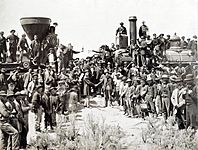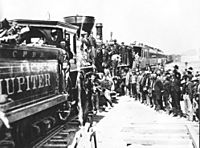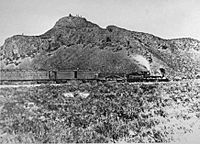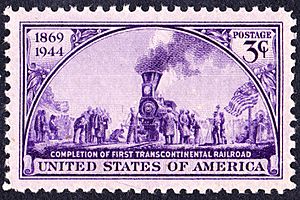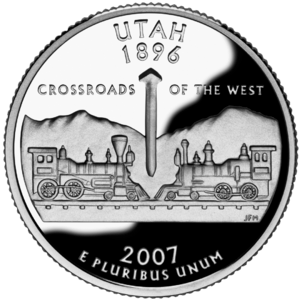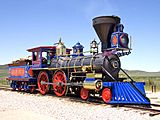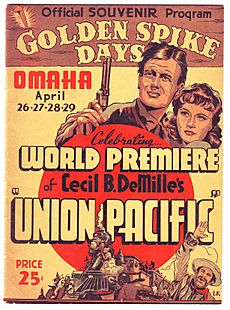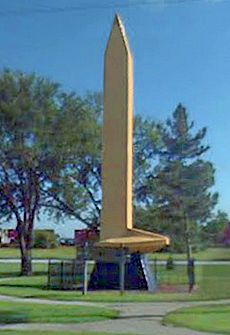Golden spike facts for kids
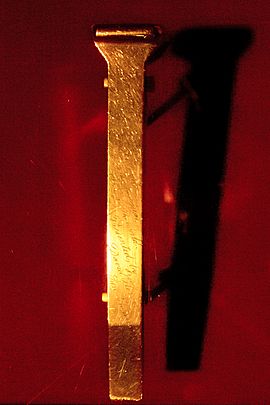
The golden spike (also known as The Last Spike) was a special 17.6-karat gold spike. It was used in a ceremony to connect the rails of the First Transcontinental Railroad across the United States. This important event happened on May 10, 1869, at Promontory Summit, Utah. The railroad linked the Central Pacific Railroad from Sacramento with the Union Pacific Railroad from Omaha. Today, the original golden spike is on display at the Cantor Arts Center at Stanford University. The term last spike is often used for the final spike driven to complete any new railroad project.
Contents
History of the Golden Spike
The idea of using a gold spike to finish the transcontinental railroad came from David Hewes. He was a businessman and contractor from San Francisco. The spike was made earlier that year by the William T. Garrett Foundry in San Francisco. It had the names of the railroad officers and directors engraved on two of its sides.
A special railroad tie, made of polished California laurel wood, was chosen for the ceremony. This was where the golden spike would be driven. The ceremony was first planned for May 8, 1869. This date was even engraved on the spike. However, it was delayed for two days because of bad weather and a workers' strike. These issues held up the arrival of the Union Pacific rail line.
On May 10, 1869, two famous locomotives met face-to-face at Promontory Summit. These were Union Pacific No. 119 and Central Pacific No. 60, also known as the Jupiter. Many people came to watch the event. Estimates range from 500 to 3,000 attendees. Government officials, railroad leaders, and track workers were all there.
Before the golden spike was driven, three other special spikes were put into the pre-drilled laurel tie. These spikes were gifts from others:
- A second gold spike, but of lower quality, was given by the San Francisco News Letter. It was worth $200 and had a message about joining the Atlantic and Pacific Oceans.
- A silver spike came from the State of Nevada. It was made of about 25 ounces of unpolished silver.
- A spike made of iron, silver, and gold was given by the Arizona Territory. It was engraved with a message about uniting the continent. This spike was given to Union Pacific President Oliver Ames Jr. It is now at the Union Pacific Railroad Museum in Council Bluffs, Iowa.
The main golden spike was made of 17.6-karat gold (73% pure gold) and weighed about 14 ounces. It was placed into a hole already drilled in the special laurel tie. Then, it was gently tapped into place with a silver ceremonial hammer. The spike had engravings on all four sides. These engravings mentioned the start and completion dates of the railroad. They also listed the names of railroad directors and officers. One side had a prayer: "May God continue the unity of our Country, as this Railroad unites the two great Oceans of the world." This was presented by David Hewes.
The golden spike was taken out right after it was tapped. This was done to prevent it from being stolen. A second golden spike, almost exactly like the first one, was also made. It was later engraved with the correct date of May 10, 1869. This second spike was kept by the Hewes family until 2005. Now, it is on display at the California State Railroad Museum in Sacramento. It is shown alongside Thomas Hill's famous painting, The Last Spike.
The crowd was very close to the railroad officials during the ceremony. This made the event a bit messy, so different stories exist about what exactly happened. The last two rails on the Union Pacific side were laid by Irish workers. On the Central Pacific side, the last two rails were laid by Chinese workers. A famous photo by A.J. Russell shows "Chinese at Laying Last Rail UPRR." Eight Chinese workers laid the last rail. Three of them, Ging Cui, Wong Fook, and Lee Shao, even attended the 50th anniversary parade. After the ceremony, the Chinese workers were honored and cheered at a dinner.
To drive the final spike, Leland Stanford lifted a silver hammer. He drove the spike into the tie, finishing the line. Stanford and Hewes actually missed hitting the spike. However, the single word "done" was still sent by telegraph across the country. This event is seen as one of the first nationwide media events in the United States. The locomotives then moved forward until their "cowcatchers" met. Many photographs were taken. Right after, the golden spike and the laurel tie were removed to protect them. They were replaced with a regular iron spike and a normal tie. At exactly 12:47 pm, the last iron spike was driven, finally completing the railroad line.
After the ceremony, the Golden Spike was given to the Stanford Museum (now the Cantor Arts Center) in 1898. The special laurel tie was destroyed in the fires after the 1906 San Francisco earthquake.
-
Photo by A.J. Russell of the celebration after the "Last Spike" was driven at Promontory Summit, Utah, May 10, 1869.
After the Ceremony
Even though the Promontory event finished the transcontinental railroad line, it didn't immediately create a smooth rail network from coast to coast. Neither Sacramento nor Omaha were seaports, and they didn't have rail connections until later. The Mossdale Bridge in California was finished in September 1869. This connected Sacramento to the rest of the line. Passengers had to cross the Missouri River by boat between Council Bluffs, Iowa, and Omaha, Nebraska, until a bridge was built in 1872. A true coast-to-coast rail link was achieved in August 1870 in Strasburg, Colorado. This happened when the Kansas Pacific Railway completed its extension to Denver.
In 1904, a new railroad route called the Lucin Cutoff was built. This new line went west across the Great Salt Lake, avoiding the Promontory location. It shortened the distance by 43 miles and had fewer curves and hills. Main line trains no longer passed over Promontory Summit.
In 1942, the old rails over Promontory Summit were taken up to help with the war effort. This was marked by a ceremony where the last iron spike was "undriven." The original event had been mostly forgotten, except by local people. They put up a marker in 1943. The next year, a special postage stamp was issued for the 75th anniversary. After the war, interest in the event grew. The first re-enactment was held in 1948.
In 1957, the U.S. Congress created the Golden Spike National Historic Site. Its goal was to keep the area around Promontory Summit looking as it did in 1869. Special companies designed and built working copies of the locomotives from the original ceremony. These replica engines meet face-to-face every Saturday during the summer for a re-enactment of the event.
For the 100th anniversary on May 10, 1969, a special steam train traveled from New York City to Promontory. This train, called the Golden Spike Centennial Limited, carried over 100 passengers, including actor John Wayne. The Union Pacific Railroad also sent a special display train.
On May 10, 2006, Utah announced that its state quarter design would show the driving of the spike. Utah's governor, Jon Huntsman Jr., chose the Golden Spike design. This happened after Utah residents voted on their favorite designs.
On May 10, 2019, the United States Postal Service released three new stamps. They marked the 150th anniversary of the golden spike. One stamp featured the Jupiter locomotive, one showed locomotive #119, and one showed the golden spike.
It's a common myth that Chinese workers are not in the famous A.J. Russell "champagne photo" of the ceremony. Many Chinese workers were not at the Golden Spike ceremony in 1869. However, they made huge contributions to building the railroad. Over 12,000 Chinese laborers worked on the western part of the rail line. They made up 80% of the railroad workers. On the 145th anniversary of the ceremony, Corky Lee gathered over 200 Chinese and Asian Pacific Americans. They created a new photo to show "photographic justice." Research by Stanford's "Chinese Railroad Workers in North America Project" proved the myth wrong. They found two Chinese laborers in the famous A.J. Russell photo. More Chinese workers are also visible in Russell's "stereo view # 539 Chinese at Laying Last Rail UPRR." Three Chinese workers believed to be at the 1869 ceremony, Wong Fook, Lee Chao, and Ging Cui, were given a place in the 50th anniversary parade in Ogden, Utah in 1919.
-
A replica of the Jupiter (CP# 60) at the Golden Spike National Historic Site.
Golden Spike Days Celebration (1939)
A big four-day event called the Golden Spike Days Celebration was held in Omaha, Nebraska. This was from April 26 to 29, 1939. It celebrated the 70th anniversary of the joining of the UP and CPRR rails at Promontory Summit in 1869. The main event on April 28 was the World Premiere of the movie Union Pacific by Cecil B. DeMille. The movie was shown at three theaters in Omaha at the same time. The film includes a detailed re-enactment of the original Golden Spike ceremony. DeMille even borrowed the real Golden Spike from Stanford University for the movie's closing scene. (A prop spike was used for the actual hammering part.)
The celebration also included the Golden Spike Historical Exposition. This was a large display of items, tools, photos, and documents from the building of the Pacific Railroad. They were shown at Omaha's Municipal Auditorium. Over 250,000 people visited Omaha during the four-day event. This was about the same as the city's population at the time. President Franklin D. Roosevelt officially opened the celebration. He did this by pressing a telegraph key at the White House in Washington, D.C.
On the same day as the movie premiere, a gold-colored concrete spike was unveiled in Council Bluffs, Iowa. This "Golden Spike Monument" is 56 feet tall. It stands near the Union Pacific's main yard, which was the starting point (milepost 0.0) for their part of the Pacific Railroad.
In Popular Culture
Artwork
- In 2012, artist Greg Stimac used the original "golden spike" at the Cantor Arts Center to create a series of photograms. These are photographs made without a camera.
Films
- The first movie to show the driving of the golden spike was The Iron Horse (1924). This was a silent film directed by John Ford. In 2011, this film was chosen for the United States Library of Congress's National Film Registry. This means it is considered very important.
- In the movie Wild Wild West (1999), the golden spike ceremony is where a bad guy tries to assassinate U.S. President Ulysses S. Grant. (In real life, President Grant did not attend the ceremony.) The large set for the ceremony was built at Cook's Ranch near Santa Fe, New Mexico.
Television
- An episode of Batman: The Animated Series called "Showdown" shows a flashback to 1883 in Utah. The governor is leading a ceremony to drive the Golden Spike. However, they are interrupted by an attack. In reality, the second transcontinental railroad was completed in 1883 in Texas, not Utah. Silver spikes were used, not gold.
- The TV series Hell on Wheels shows the building of the transcontinental railroad over several seasons. In one episode, a character claims to have a ring made from part of the ceremonial golden spike.
Trains
- The Inyo, a steam locomotive built in 1875, appeared in the Golden Spike ceremony scene in the movie Union Pacific (1939). It also appeared in the 1960s TV series The Wild Wild West. In May 1969, the Inyo took part in the Golden Spike Centennial in Promontory, Utah. It then served as the replica of the Central Pacific's Jupiter (CPRR #60) at the Golden Spike National Historical Site until a new replica was built in 1979. The Inyo was bought by the Nevada State Railroad Museum in 1974. It was fully restored in 1983 and still runs today.
es:Primer ferrocarril transcontinental de Estados Unidos#Golden Spike




